A collection of commonly encountered spiders in the Bay Area, assembled by Dr. Stephen Lew. Note that to the untrained eye many spiders look similar – having a spider in hand will be much easier to identify than a fuzzy cell phone photo and trying to remember what it looked like running away. Spiders also are accused of biting people (or worse), but very rarely has this ever been witnessed.
Other web resources:
UC IPM pest management guide to spiders
Common garden spiders video
How to identify and misidentify a brown recluse spider
SpiderBytes blog
Spiders.us
Aphonopelma spp. (Theraphosidae) – “Tarantula”
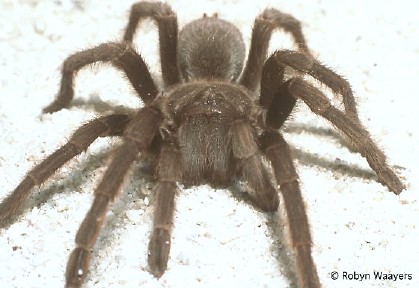
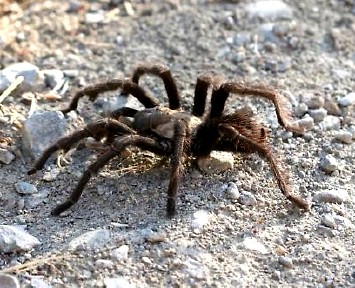
All of California’s native tarantulas are in the genus Aphonopelma. They often are found in pool filters. The females live in burrows and are occasionally dug up in gardens. Males are often seen wandering in search of females in the fall. [Left: Aphonopelma sp. (photo: Robyn Waayers), Right: Aphonopelma sp. (photo: Will Chatfield-Taylor)]
Calisoga longitarsus (Nemesiidae) – “Calisoga spider,” “False tarantula.”
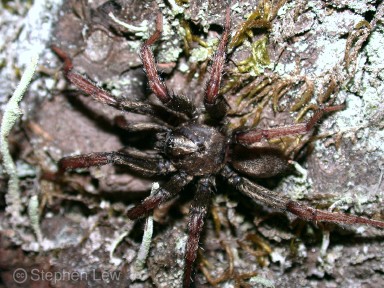
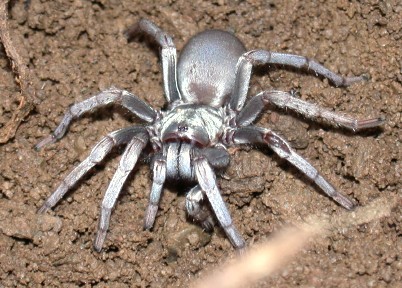
“I can’t believe it’s not a tarantula!” Often mistaken for a tarantula, Calisoga is smaller and unable to climb smooth surfaces. Very frequently encountered in the Oakland hills. There is considerable variation in color and form. The similar Calisoga thevenetti is less frequently seen. As with tarantulas, the spiders are usually safely hidden in their burrows, and wandering males are the most likely to be encountered. [photos: Stephen Lew]
Dysdera crocata (Dysderidae) – “Sow-bug killer”
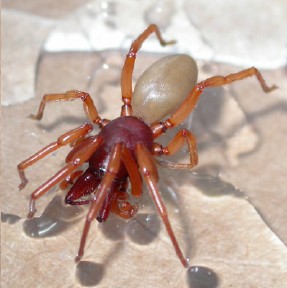
A mediterranean invasive, this spider is usually found under wood or bark. [photo: Peter J. DeVries]
Pholcus phalangioides & Holocnemus pluchei (Pholcidae) – “cellar spider”
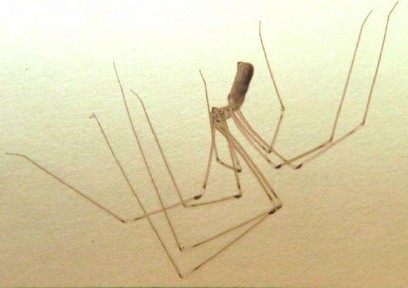
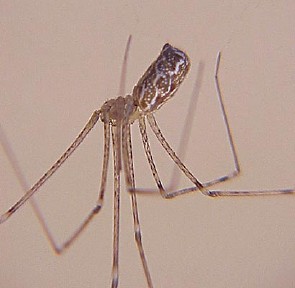
The common synanthropic cellar spiders in California are European invasives, native pholcids are much smaller. Sometimes confused with “daddy long-legs”, which are not spiders, but rather Opiliones (“harvestment”). Pholcus can be distinguished from Holocnemus (“marbled cell spider) by the grey/brown concolorous abdomen. Their webs are irregular tangles. When disturbed the spiders often gyrate in their webs. [left: Pholcus (photo: Jerome Rovner), right: Holocnemus (photo: I.R. Lindsey)]
Latrodectus herperus (Theridiidae) – “black widow”
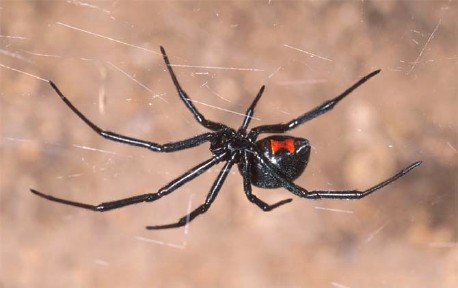
This is the only spider that you are likely to encounter in California whose venom is medically significant. The red hourglass may be yellow or orange, and may not actually be shaped like an hourglass. Males and immature females are not solid black, and have attractive marble-like patterns on their abdomens. Makes a typical theridiid tangle web. [photo: Bryan Reynolds]
Steatoda grossa & Steatoda nobilis (Theridiidae) – “false widow”

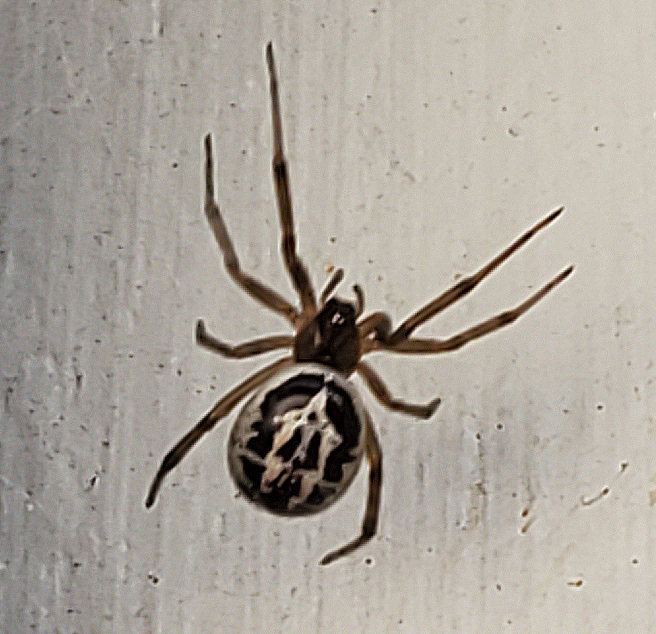
Two other European invasives, these spider seems to be displacing our native black widows in urban areas. These spiders are roughly the same size and shape as a black widow, but are brown with a faint purple sheen. They make typical theridiid tangle webs. Left: Steatoda grossa [photo: Cheryl Moorehead], Right: Steatoda nobilis [photo: Grant Boyadjian].
Parasteatoda tepediorum (Theridiidae) – “American house spider”

A common invasive, believed to be from South America. Makes a typical theridiid tangle web. [photo: Tom Adams]
Araneus diadematus (Araneidae) – “cross orbweaver”, “European garden spider”
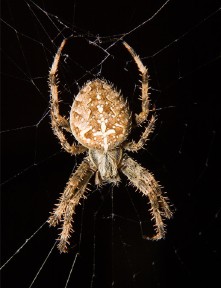
Another European invasive, this spider can become quite imposing in size and density in the late fall. Makes a large vertical orb web. [photo: Diogo Verissomo]
Cyclosa conica (Araneidae) – “trashline orbweaver”
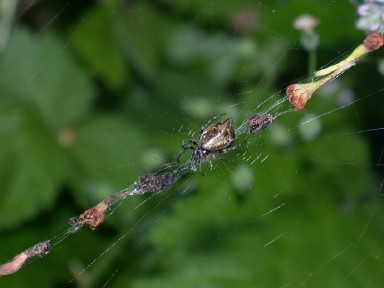
This orbweaver decorates its vertical orb web with a line of debris, in which are hidden the spider and egg sacs. [photo: Stephen Lew]
Argiope spp. (Araneidae) – “silver garden spider”, “yellow garden spider”, “banded garden spider”
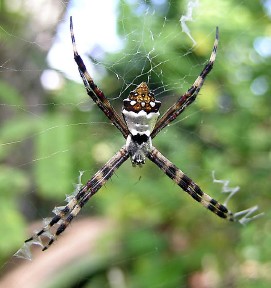
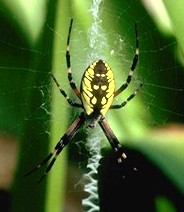

Common in gardens, makes an orb web with conspicuous, shiny, radiating “stabilimenta”. [left: silver, Argiope argentata (photo: Sean McCann), middle: yellow, Argiope aurantia (photo: Jo-Ann Ordano), right: banded, Argiope trifasciata (photo: Bruce Marlin)]
Zygiella x-notata (Araneidae) – “missing sector orb weaver”
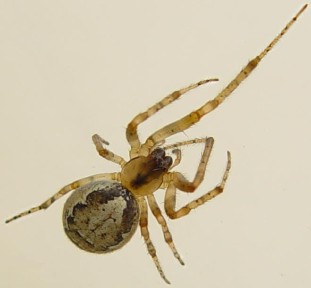
Another common invasive, this spider makes a vertical orb web with two sectors missing, looking like a pizza with a single slice missing. [photo: Ian Pembroke]
Neriene digna (Linyphiidae) – “money spider”
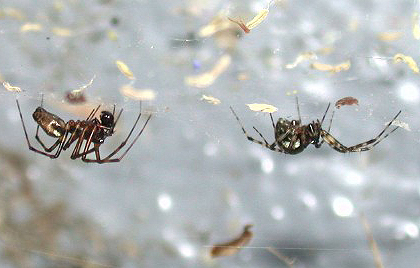
There are lots of linyphiids, and the taxonomy is a real mess. Linyphiid webs are usually flat sheets under which the spider hangs upside-down. Neriene digna (photo of courting pair, male on left) is particularly common in the Bay Area in the spring. [photo: Stephen Lew]
Agelenopsis spp. (Agelenidae) – “grass spiders”
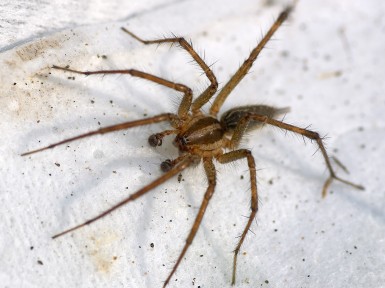
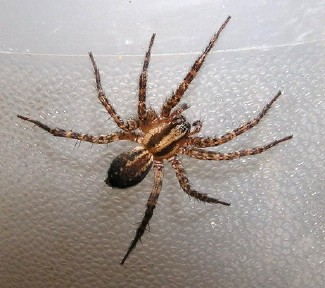
Grass spider webs are ubiquitous on evergreen shrubs and tall grass. The dense webs form a sheet that narrows to a tube or funnel where the spider hides awaiting prey on its web. Their cousins (Tegenaria spp., Agelenidae), including the domestic house spider and hobo spider, are more common indoors in some parts of the western states. The light stripe on the carapace of the grass spiders can be confused with some wolf spiders (Lycosidae). However, wolf spiders do not build webs to capture prey. [Photos: Ray A. Akey (left), Marian Cronen (right)]
Pardosa spp. (Lycosidae) – “wolf spiders”
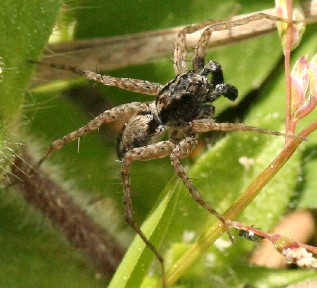
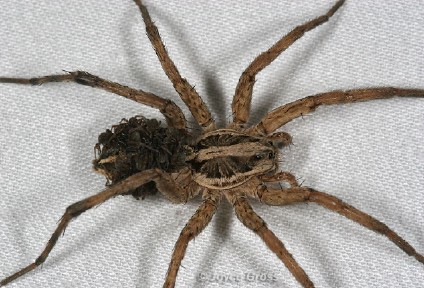
Wolf spiders are difficult to identify even to genus without a microscope, but most found around homes turn out to be in the genus Pardosa. Females are often seen carrying their egg sacs on their spinnerets, or carrying spiderlings on their backs. Wolf spiders do not make a web except for the infrequently seen Sossipus which makes a sheet web. [Photos: Lynette Schimming (left), Joyce Gross (right)]
Anachemnis spp. and Titiotus spp. (Zoropsidae)
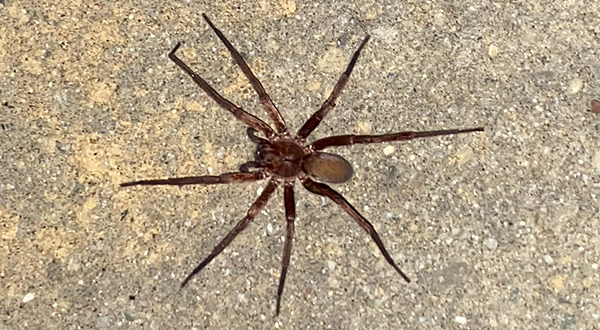
Zoropsids (a.k.a. tengellids) are sometimes confused with brown recluse (which do not occur in California), but lack the violin-shape pattern on the carapace, and have eight eyes rather than six. Titiotus californicus (above) is the most common species of this family in the Bay Area. [photo: Heather Lee]
Zoropsis spinimana (Zoropsidae) – “zoropsids”
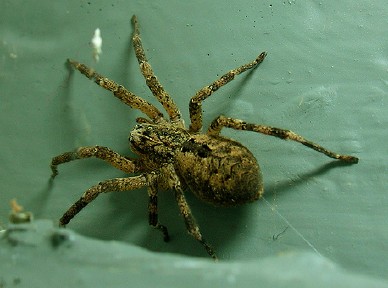
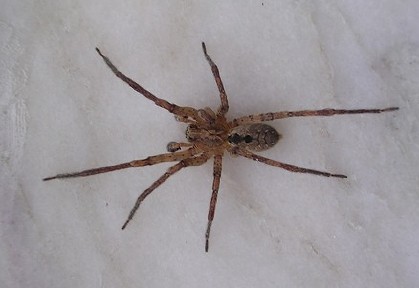
A recently arrived mediterranean invasive, now found in the Bay Area. For more information, read the UC IPM information page for Zoropsis spinimana. [left: female (photo: Anca Mosoiu), right: male (Omeuceu)]
Badumnas longinua (Desidae) – “black house spider”
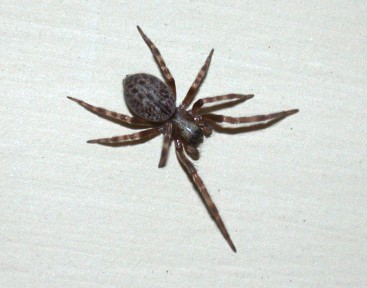
This invasive spider is native to Australia and New Zealand. The web is a mesh, often with a distinct lattice pattern, commonly seen on fence posts, street signs, and side-view mirrors. [photo: Stephen Lew]
Peucetia viridans (Oxyopidae) – “green lynx spider”
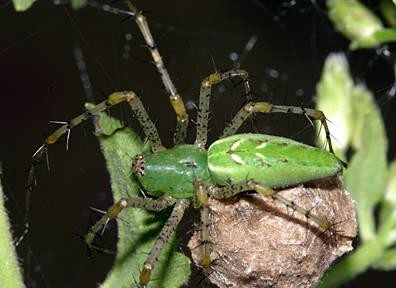
Common in gardens. Often seen guarding egg sacs. Less frequently seen is P. longipalpis. lynx spiders do not make webs. [photo: Tom Murray]
Cheiracanthium spp. (Eutichuridae) “yellow sac spider”
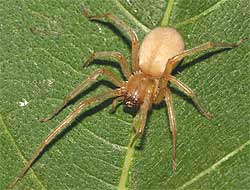
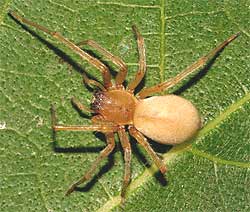
Cheiracanthium inclusum (pictured here) is common in agricultural settings, and C. mildei is common in homes. They are anecdotally associated with mildly symptomatic envenomations, but there are no studies or data supporting this. Yellow sac spiders do not make a web, but may make a conspicuous molting chamber. [photos: Jim Berrian]
Misumena vaita (Thomisidae) – “crab spider”
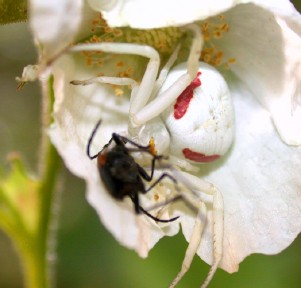
Ranging in color from white to yellow, Misumena species are often found on or under flowers where they wait for their prey. Rather than make webs, these spiders are sit-and-wait predators. [photo: Stephen Lew]
Olios spp. (Sparassidae) – “sparassids”
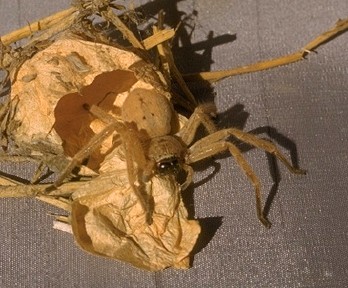
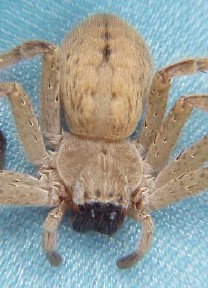
[photos: Glenn & Martha Vargas (left), I.R. Lindsey (right)]
Phidippus spp. (Salticidae) – “jumping spiders”
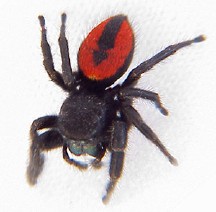
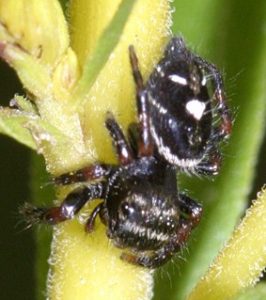
There are many jumping spiders around the home and garden, but of the common ones Phidippus are the most conspicuous. Jumping spiders are visual, day-time hunters with large frontal eyes, and do not make webs. [left: P. johnsoni (I.R. Lindsey), right: P. audax (photo: Tom Murray)]
